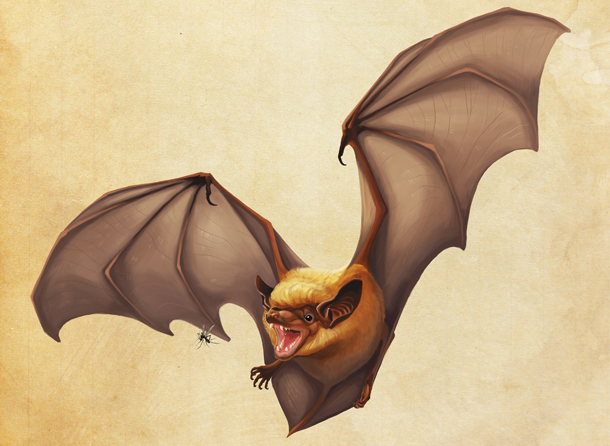
Illustration by Virginia Greene
October 26, 2016
Going Batty
In honor of National Bat Week, which ends, appropriately, on Halloween, we do some myth-busting about one of Charleston’s native flying mammals, the “big brown”
written by Suzannah Smith Miles
If you’ve ever encountered bats roosting in the eaves or attic of your Holy City home—or, scarier still, had a stray critter flapping through your living quarters—there’s a fair chance it was of the “big brown” variety (Eptesicus fuscus). Among the largest of the 14 species of bats indigenous to South Carolina, these creatures of the night regularly set up residence in human houses and outbuildings (but may also sleep away the days inside tree cavities and bark crevices). At sundown, Earth’s only flying mammals emerge to hunt winged insects, capturing mosquitoes and more with their mouths as well as their scoop-like tail membranes. Here, find a few more fun facts.
Dark Secret: Bats are not actually blind, but like all mammals, they cannot see in complete darkness. Thus they use echolocation, creating a steady stream of sounds with their mouths (inaudible to us) that bounce off nearby objects to help them find their way in the dark.
Invite Company: Habitat loss poses a major threat to bats across the world. To shelter a colony in your own backyard, install a house that’s certified by Bat Conservation International. Locally, Wild Birds Unlimited is a good source for these boxes that must be hung 12 to 20 feet above the ground.
Safety First: While bats are often believed to carry rabies, only one-half percent of them actually have the virus. However, their tiny teeth marks are hard to detect, so if one is found inside with a snoozing human or unattended child, that person should seek medical attention. If possible, have the bat professionally captured and tested for rabies by the South Carolina Department of Health and Environmental Control.
Health Scare: Across the country, bat species that hibernate (including big browns) are dying at an alarming rate from white-nose syndrome, a disease that was found in South Carolina in 2013 and has been spreading since. The fungus that causes it thrives in cool, humid places with minimal airflow, and while humans aren’t affected by it, they can transport its spores.
Twisting Words: The long-lived phrase “going batty” comes from the aerodynamic critters’ often-erratic flight—their habit of making sudden turns and twists while chasing prey. The bat’s wings are flexible, with muscles that allow them to move more like human hands than bird wings, which operate as single units.
Dinner on the Fly: Though small (four to five inches long, on average), big browns consume an unbelievable amount of food, including moths, flies, beetles, mosquitoes, and even wasps. A single animal can gobble up a third of its weight in one night. This natural form of pest control is vital to reducing insect populations that plague crops, as well as those that carry diseases harmful to humans.
To read more articles in our So Charleston series, click here.
To check out our new November issue, click here.
|
 |